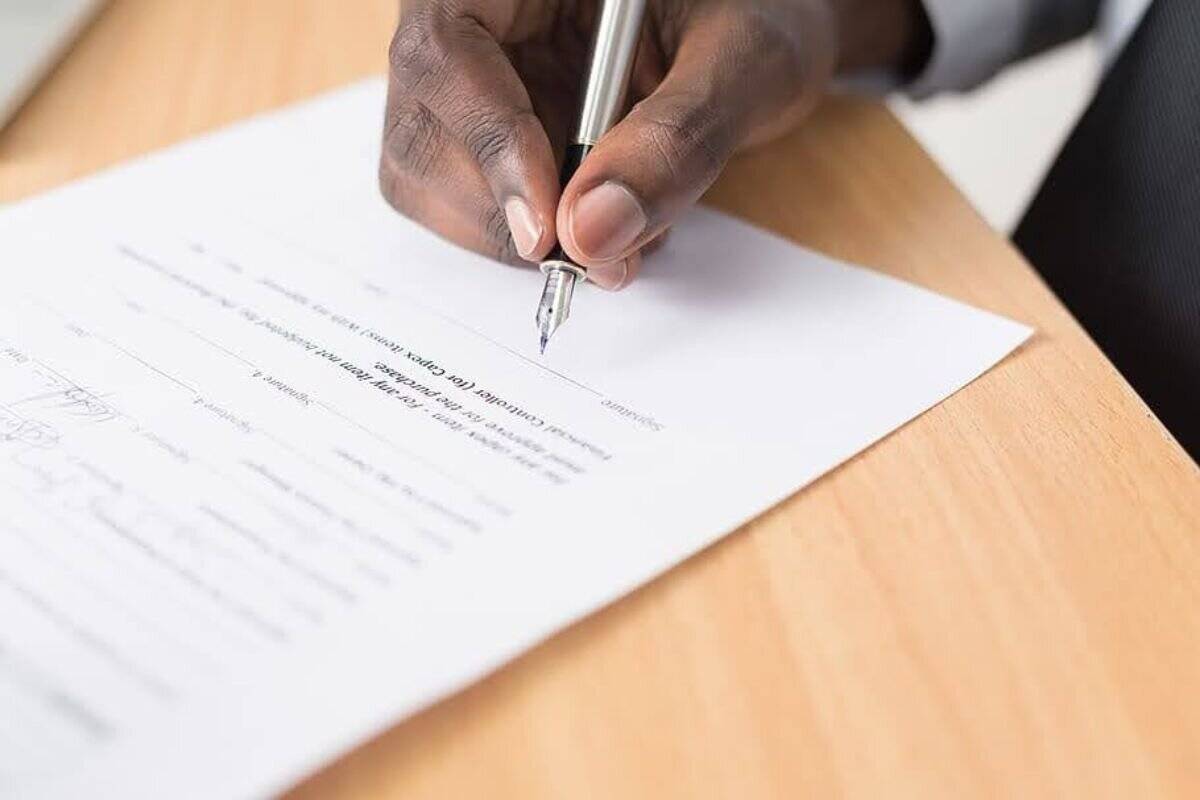Writing the body of a letter is easy, but when it comes to wrapping things up, even professional writers can get stuck.
So, what is it about the conclusion that suddenly has most of us overcome with writer’s block?
It’s because the ending is the part that people remember.
Regardless of whether you’re writing a quick memo to the boss or an epic love letter, the ending is a written equivalent of a mic-drop.
Deep down, we know it has to not only have impact, but it also must be formatted correctly.
So if you’ve ever Googled how to end a letter and been left staring at ten different “kind regards” options, don’t worry. It’s far more common than you would think.
Whether you’re writing to a hiring manager or someone you love, this guide is going to break down the ways to finish a letter strong.
Key Takeaways
- Your letter ending needs to match the tone and purpose of the message: formal, friendly, or emotional.
- The final paragraph is your last chance to reinforce your message and get a response.
- Closing phrases should feel natural for the relationship and context.
- Formatting is important, so include contact details where needed.
- AI tools are making writing polished and tone-appropriate letter endings much easier.
Why a Letter Ending Matters More Than You Think
Most people focus on the main content of their letter and then treat the ending like an afterthought. That’s risky.
The closing is the part that really lingers and can actually set the tone for the entire letter itself.
Think about it.


Never Worry About AI Detecting Your Texts Again. Undetectable AI Can Help You:
- Make your AI assisted writing appear human-like.
- Bypass all major AI detection tools with just one click.
- Use AI safely and confidently in school and work.
An emotional message that ends with “much appreciated” will probably leave a reader confused, while a formal letter that ends with “cheers!” will destroy any professionalism you were trying to convey.
A recent study by Preply found that the most common email sign-offs were “Thank you,” “Thanks,” signing off with just a name, and “Thanks in advance.”
These endings are all good for a quick email, but in a letter, they come across as too abrupt or even aggressive.
Imagine sending a resignation letter that ends with “Thanks” versus “With appreciation.” Same basic idea, wildly different tone.
That’s why knowing how to end a professional letter (or any letter, for that matter) can change the whole message.
The Key Elements of a Letter Ending
A strong letter ending consists of multiple parts. Each one plays a role in how the reader feels once they’ve finished:
- The final paragraph: Where everything gets tied together. Here, you’ll restate your main point(s), offer some gratitude for reading this far, and give a clear next step.
- Closing phrase (sign-off): This is the bridge between your message and your name.
- Signature and contact information: In professional settings, you add your full name, title, and contact details.
- (Optional) P.S.: The Post Script, something extra or additional to add right at the end in a single sentence. Handy in the days when letters were all handwritten.
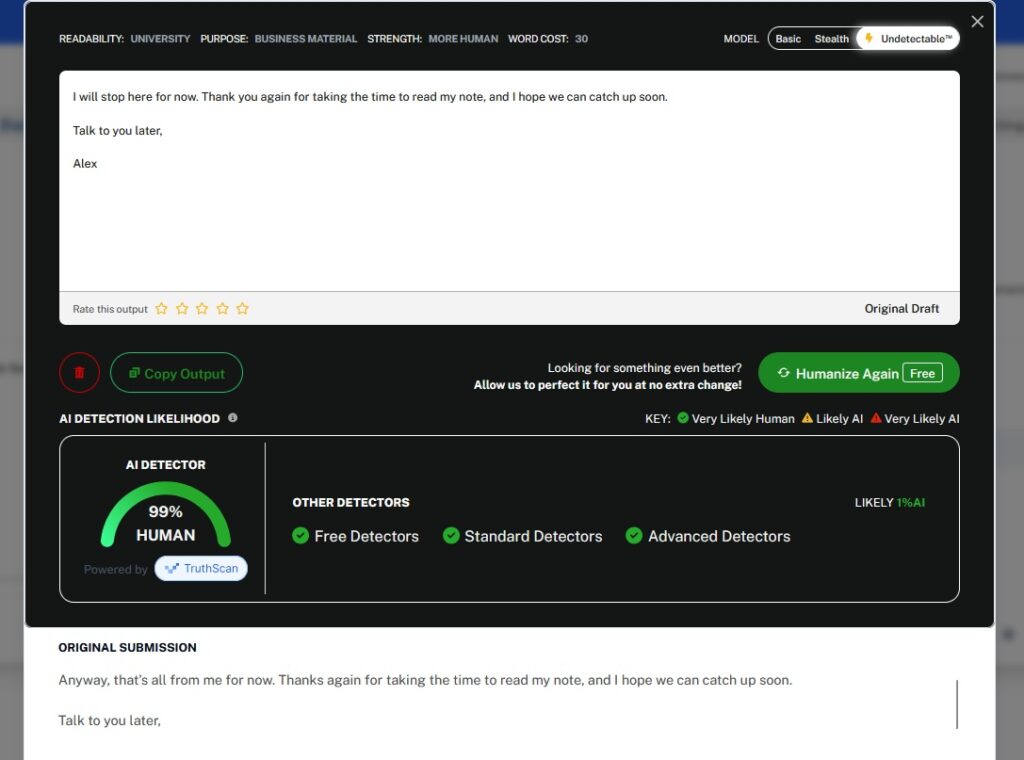
If you’re unsure about the overall tone of your ending, a good place to start is by using Undetectable AI’s AI Humanizer.
You can select from options like “cover letter,” “business,” or “personal,” and it will rephrase your ending so it’s exactly what you need for your given situation.
How to Write the Final Paragraph
The final paragraph is where you bring your letter to a smooth and natural close.
You can think of it as your “last word.” It’s the moment to reinforce your point without rehashing everything you’ve already said.
If you’re writing a final paragraph for a business letter in a formal setting, this paragraph should be focused and purposeful.
If you’re writing a cover letter, the final paragraph would restate your interest in the role and then invite the employer to contact you.
Here are a few ways to make your final paragraph work for your letter:
- Restate your intent in one sentence. For example: confirm the meeting, express interest, and thank them for their time.
- Add a call to action (CTA) so the reader knows the next step to take. This could be a reply, a phone number, setting up a meeting, or clicking on a link.
- Leave a positive impression always by showing appreciation or confidence.
- Match the tone to your letter type. Warm and personal for friends, concise and formal for business.
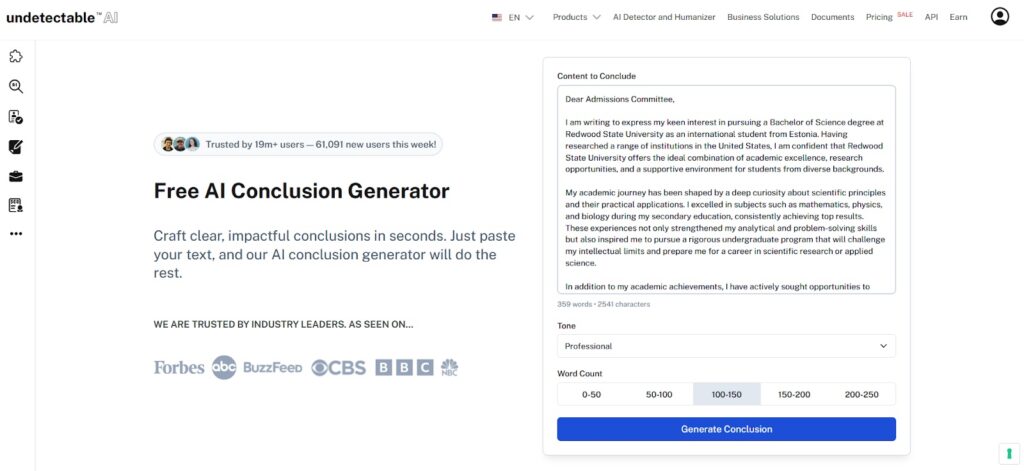
If you do find yourself stuck for ideas on how to conclude your letter, the Undetectable AI’s AI Conclusion Generator can analyze your current content and create the perfect ending based on your tone of voice, style, and topic.
It’s as easy as pasting your unfinished letter into the tool and generating a conclusion.
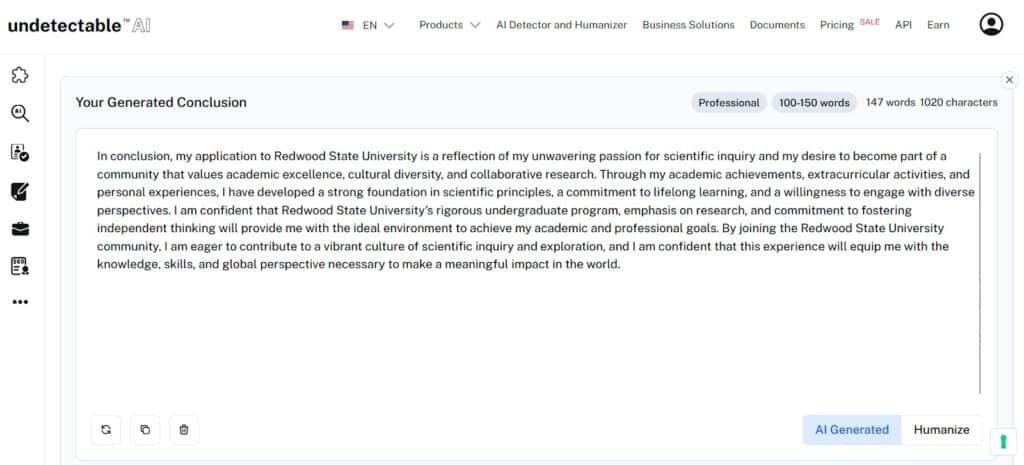
Common Letter Closing Phrases
Choosing the right closing phrase might seem like a minor detail, but it’s actually one of the most powerful parts of your entire letter.
The sign-off phrase always starts with a capital letter on the first word and ends with a comma.
Below are some common examples of both formal and casual closing phrases.
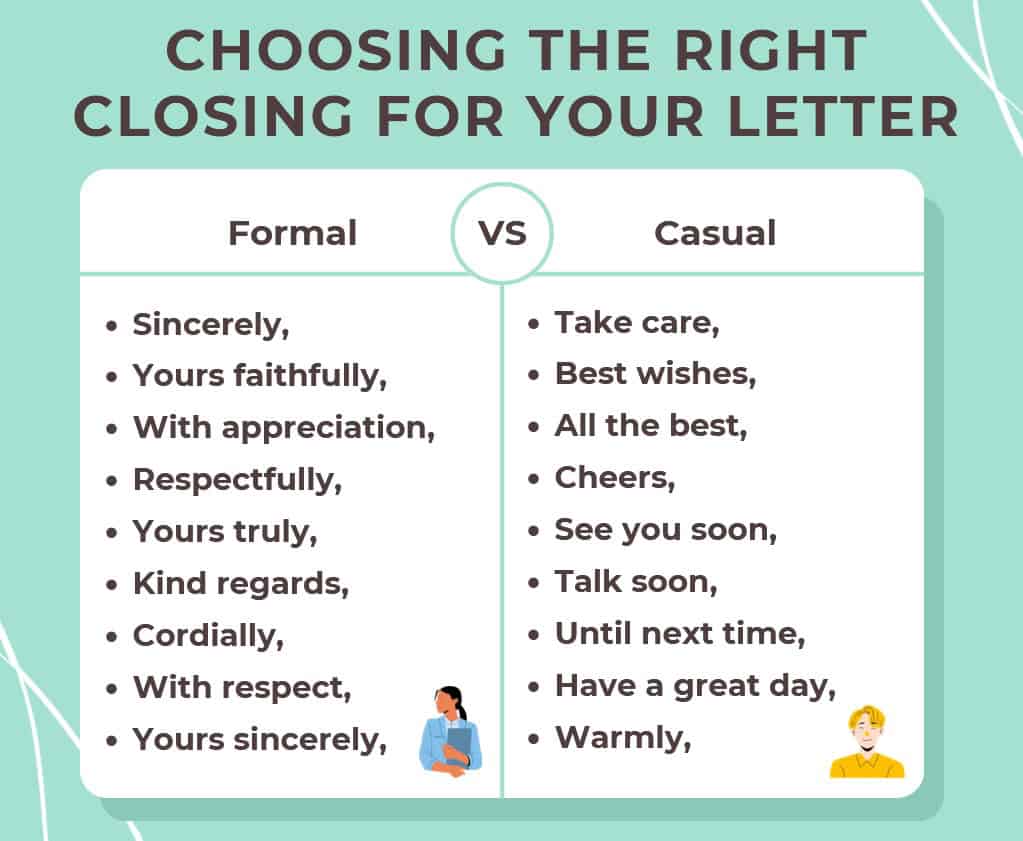
Here are the more commonly used options and when to use them:
- Sincerely: You’ll see this one in most American English formal letters, and it works well in almost every professional context.
- Yours truly: A little warmer than “Sincerely,” it’s another common American English ending.
- Kind regards: Use this one when you want to express some warmth but still retain a formal tone of voice.
- Warm wishes: A warm, gentle, and personal sign-off that can still be used in some professional contexts.
- All my love: Only use this sign off with close relationships and loved ones. It should never be used in a professional environment.
- Take care: Very approachable, warm, and casual. It’s best used with friends, family, or colleagues at work you know well.
There are some subtle but important differences between US and British English when it comes to using the more formal ending phrases.
“Yours sincerely” is used in British English only when the opening of the letter is addressed to someone by name (for example: Dear Alex Johnson).
In British English, “Yours faithfully” is reserved for letters only opening with “Dear Sir/Madam.”
If you are writing correspondence in British English, these rules should be taken into account. However, in the US, “Sincerely” or “Yours Sincerely” work for any formal letter.
How to Format the Signature
The signature at the end of your letter represents both your name and your credibility.
A signature is your unique personal mark that represents you and your approval and authorship of what has been written.
When you sign something, you’re essentially saying “I agree with this” or “I stand by this.”
In a legal context, it’s an acknowledgment that carries the same legal weight as your spoken agreement.

When it comes to letters, there are three common formats:
- Printed or handwritten: The most traditional. A handwritten signature feels personal, especially on formal printed letters.
- Typed name: It works for internal communications or informal exchanges when a physical signature isn’t needed.
- Digital signatures: These are secure, legally binding, and convenient for remote or time-sensitive communications. They use encryption to verify the signer’s identity and prevent tampering.
In a traditional closing, your signature sits below your closing phrase and above your printed name and contact details. For example:
Sincerely,
[Handwritten/Printed signature]
Alex Johnson
Marketing Director
+1 (555) 123-4567
LinkedIn: linkedin.com/in/alexjohnsson
WhatsApp: +1 (555) 123-4567
If the letter is digital, you can replace the handwritten or printed signature with a digital signature file, but it will still appear in the same place.
Platforms like DocuSign, Adobe Acrobat Sign, and HelloSign allow you to create, store, and insert a signature directly into your document.
How to End a Letter in Spanish
Ending a letter in Spanish follows many of the same principles as English, but the choice of closing can depend heavily on formality and regional norms.
In a professional setting, formality is typically maintained. In personal letters, the ending can be much warmer.
These are three common Spanish closings to get you started:
- Atentamente: Equivalent to “Sincerely,” used in formal business or official letters.
- Cordialmente: Similar to “Kind regards,” polite and slightly warmer than Atentamente.
- Con cariño: Translates to “With affection,” best for close friends or family.
As with most languages spoken over several regions, there are some differences from country to country.
In some Latin American countries, Atentamente is almost always used for business. In Spain, Cordialmente is more common in polite but not overly formal correspondence.
For more examples, SpanishDictionary has some great explainers and goes into more depth for English speakers interested in correspondence in the Spanish language.
Sample Letter Closings
Sometimes it’s easier to see the rules in action.
Below, we’ve given some examples of how different letter types end. Each one is short, clear, and fits the tone and purpose of the message.
Feel free to use these as templates, then adjust them for your own voice and situation.
How to End a Cover Letter or Job Application Letter
I appreciate the time you have taken to review my application. I look forward to the opportunity to discuss how I can contribute to your team.
Sincerely,
[Signature]
Jordan Smith
555-123-4567
Portfolio: jordansmithcontentcreator.com
How to End a Formal Business Letter
Please don’t hesitate to contact me if you need any additional clarification on this matter.
Kind regards,
[Signature]
Michael Brown
Director of Operations
How to End a Personal Thank-You Letter
Your kindness means so much to me, and I am truly grateful for both your generosity and support.
Warm wishes,
[Signature]
Mayal Patel
Facebook: facebook.com/mayascharity
How to End a Letter to a Teacher or Mentor
I thank you for all your guidance and valuable lessons you have shared over the years.
With appreciation,
[Signature]
Emma Wilson
How to End a Love Letter
My love, I count the days, hours, and minutes until I can hold you again. You are my safe place, my joy, and I love you with all my heart.
All my love,
[Signature]
💖Isabella
Using Undetectable AI’s Suite to Get the Perfect Ending
If you need some help in phrasing your final letter sign-off, the Undetectable AI’s AI Chatbot is an interactive tool designed to help with this task and more.
Based on your prompts, it will create a polished and ready-to-use ending for your letters in seconds, regardless of the topic and style.
Below, we’ve outlined how to use it to improve your finishing paragraph and sign off.
1. Go to the Undetectable AI Chatbot and enter your prompt
In the Undetectable AI Chatbot, type in a detailed request for what you need. The more specific you are, the better and more accurate your results will be.
Here is the prompt that we used:
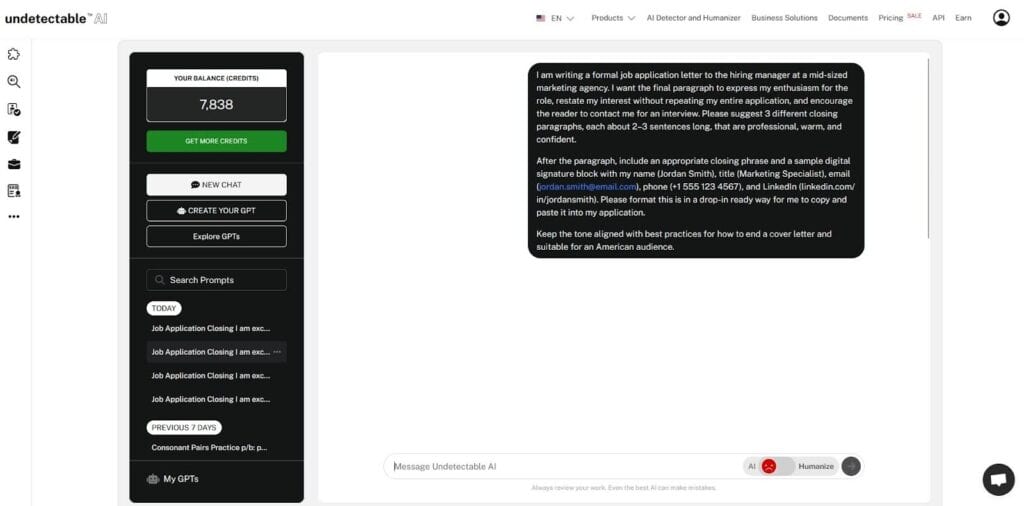
Specifying details like needing a drop-in version of the letter ending will help format it correctly.
2. Review Multiple Versions
The AI Chatbot will return several final paragraphs and sign-off combinations.
Read them carefully and pick the one that best matches the tone and style you want.
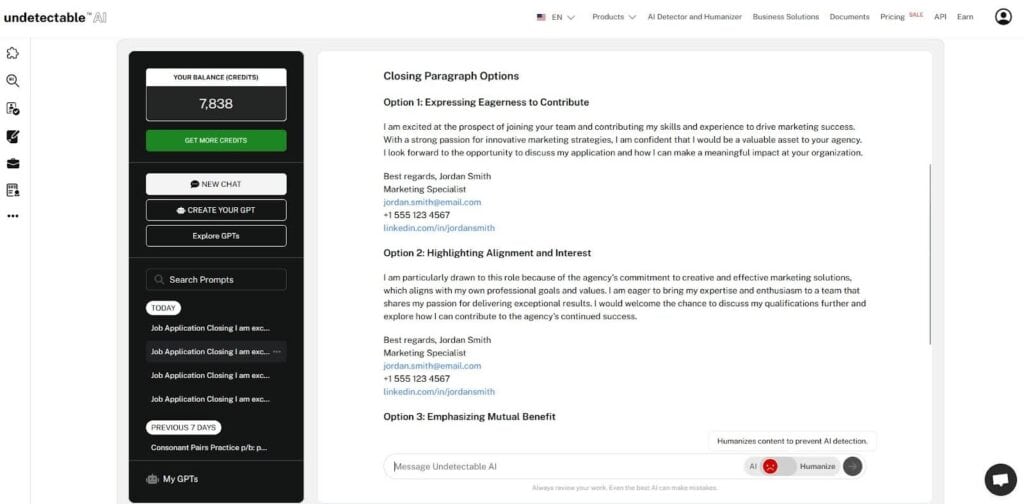
If you need to refine it, you can ask the assistant to make changes.
For example, if you want to sound more confident, request the Chatbot to restyle and adjust the language so it feels more professional.
If you need a more creative response, get the Chatbot to create a more natural and creative style and tone.
3. Humanize the Response to Make It Sound Even More Natural
Straight AI-generated text can sometimes feel quite stiff or overly formal.
To generate more human-sounding and natural letter endings, use the Undetectable AI Humanizer functionality within the Chatbot or the AI Humanizer tool.
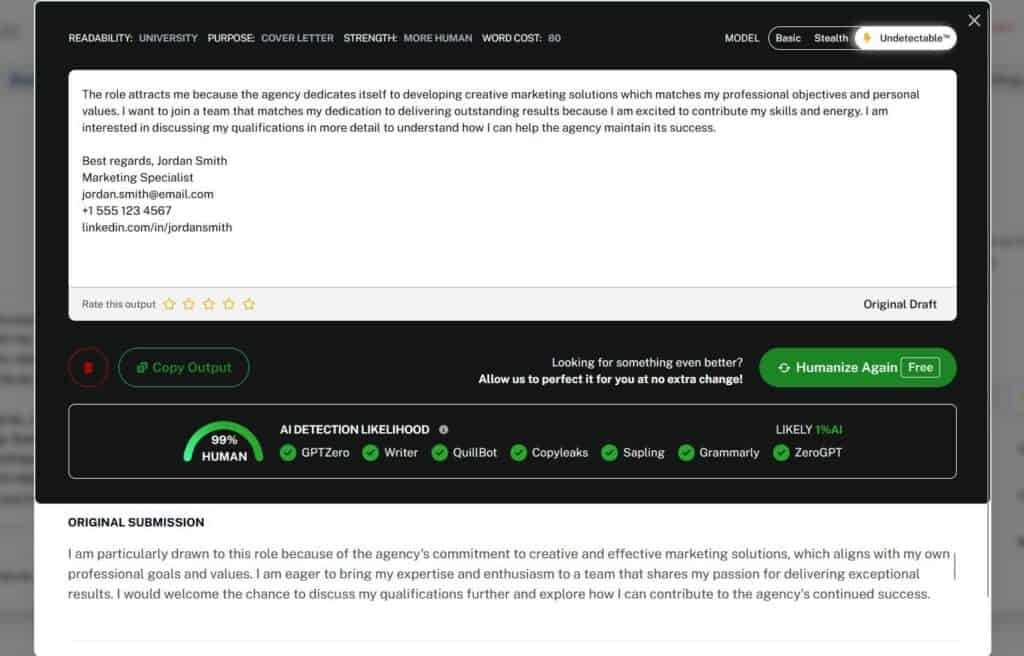
You can select the readability level to match that of your audience, and adjust the output to be more professional, creative, or even cover letter specific.
Simply paste the text into the Humanizer and watch the tool create a more human ending paragraph that feels natural while staying professional.
Try out our AI Detector and Humanizer in the widget below!
Wrapping It Up the Right Way
If you want your letter to have the impact you intended, it needs to end on a strong note.
Ultimately, that last paragraph and the words you choose to sign off shape the reader’s perception of the content that came before it.
The best way to leave the right impression is to use your authentic tone combined with a clear structure.
Stuck on how to conclude your letter? the Undetectable AI AI Humanizer and Conclusion Generator can help guide you in the right direction, creating endings to letters that always feel appropriate, natural, and authentic to your unique message and style.
Our suite of AI tools can help you refine and fix awkward phrasing that would otherwise make your letters fall flat.
Explore our range of writing tools today to create letters, articles, and blogs that always feel confident and completely your own.
